Blower Clears Established Firelines in Hardwood Forests Without Disturbing Soil
Shawnee National Forest Time and Motion Study
Before the KB3 blower was purchased, a Buffalo Turbine representative demonstrated its use. The demonstration model, which was on a trailer towed behind a six-wheeled UTV, appeared to be suitable for clearing fireline, but could not access all of the fireline that needed to be cleared. A blower mounted in the back of the UTV would allow the UTV to be more mobile and to handle the terrain better. Although the factory offered a rigid air chute, it probably would have been damaged on the forest's steep, uneven terrain. The Missoula Technology and Development Center (MTDC) purchased the Buffalo Turbine Cyclone KB3 debris blower and modified it based on recommendations from the Shawnee National Forest. Modifications included developing a flexible air chute, devising a way of mounting the unit in the back of the UTV, and adding four frame attachment lugs to the blower so a fork lift could lift it into and out of the UTV.
Mounting the Blower in the UTV
Forest Service employees reinforced the bed of the UTV. Before mounting the blower, two 4- by 36- by ¼-inch pieces of flat steel were attached to the underside of the bed using two 3⁄8- by 3-inch stainless steel bolts per piece of steel. Holes were drilled through the crossmembers of the bed of the UTV (figures 16 and 17). The blower was secured using four 3⁄8- by 3½-inch stainless steel bolts running through the blower, the bed of the UTV, the crossmembers of the UTV's bed, and the flat pieces of steel.

Figure 16—One of two pieces of flat steel was installed
to strengthen the
bed of the UTV.

Figure 17—Bolts pass through the bed of the UTV, a crossmember,
and one
of the pieces of flat steel.
Lifting Bars
Forest Service employees fabricated two lifting bars to help lift the blower in and out of the UTV. The lifting bars are made of 1½-inch outside diameter, 14-gauge hollow steel tubing. Safety pins keep the lifting bars in place while the blower is being lifted into the bed of the UTV and allow the blower to be removed quickly, if necessary (figure 18).

Figure 18—Locking pins keep the lifting bar in place when the
blower is
being lifted into the bed of the UTV.
Flexible Chute
MTDC manufactured a flexible blower chute out of heavy, nylon-coated fabric (Style 3026 OBU fabric for oil boom systems by Seaman Corp., Wooster, OH) and attached the chute to a modified aluminum air duct fitting. The chute is 34 inches long, measures 14 inches in diameter at the base, and tapers into a 14- by 6-inch rectangle at the end (figure 19). The chute needed to be flexible when being dragged through steep creek crossings or over stumps and logs. The nylon chute was bolted to an aluminum fitting that was clamped to an aluminum elbow. The clamps allowed the chute to be taken on and off easily. The chute could be set up with different angles, depending on the elbow used.

Figure 19—The flexible chute developed by MTDC.
Mud Flap
A piece of 1-inch-square tube (36 inches long) was attached to the blower's frame. The tube secured a piece of rubber conveyor belting. The flap came to within 6 to 8 inches of the ground (figure 20).

Figure 20—The mud flap developed to help keep debris from blowing
under the UTV.
Fireline Construction
Fireline was cleared on a number of prescribed burn units in hardwood leaf litter and pine straw ground cover. Before the blower was used, chain saws were used to remove small trees and logs, allowing access for the UTV (figure 21).

Figure 21—A fireline after trees had been cut,
before the line was blown
clear.
One person operated the UTV, while another person controlled the blower with a remote control while walking behind the UTV (figure 22).

Figure 22—The UTV driver and an operator using a remote control to
manipulate the blower work together during standard operations.
The remote control was used to adjust the blower's throttle and rotate the chute. The blower operator used a radio to let the UTV operator know to go slower or faster. During fireline construction, a stopwatch was used to time blower operations. The fireline was measured to establish output in chains per hour. A chain (66 feet) is a common distance measurement in forestry project work and wildland firefighting. The fireline was cleared during a single pass. During each pass, all chute angles and the throttle speed remained constant. Employees wore personal protective equipment during operations.
Results of Blower Tests
Mounting the blower in the back of the UTV improved the UTV's mobility. The pieces of steel under the bed of the UTV kept the blower from moving when it was being transported or used.
The flexible chute helped prevent problems when the UTV was crossing creeks and traversing uneven terrain. Elbows were used to create a 90-degree angle, pointing the chute directly at the ground. Eddies blew debris under the UTV, where it collected around the muffler (figures 23 and 24).

Figures 23 and 24—Flammable debris packed
around the UTV's hot muffler.
The hot muffler ignited the debris, causing a small fire. A mud flap (see figure 20) was attached to the bed of the UTV to try to decrease the amount of debris accumulating under the UTV. The flap actually caused more debris to accumulate around the hot muffler and in the UTV's engine compartment, causing another small fire threat.
Field testers believed that even if the flap reached all the way to the ground, debris would still collect under the UTV. The mud flap created another problem—the UTV could not be backed up without first lifting the flap. Otherwise, the flap got caught by the tires.
Jon Teutrine, Hidden Springs Ranger District, requested that a 22½-degree elbow section be manufactured to allow the chute to point backward slightly rather than straight at the ground (figure 25). Buffalo Turbine provided the elbow.
Less debris built up under the UTV with this arrangement. There was no recognizable difference in the amount of line construction whether the chute was pointing straight down or pointing out slightly.

Figure 25—The blower with its chute pointing slightly out rather than
straight at the ground.
Fireline construction (measured in chains per hour) was completed in hardwood leaf litter and pine straw, in wet and in dry conditions. Firelines used during prescribed fires must be cleared to expose bare mineral soil for a width of at least 36 inches (figure 26).

Figure 26—Usable fireline for prescribed fire. The photo shows the same
area as figure 21 after the fireline has been cleared by the blower.
Fireline construction was fastest in dry leaf litter and slowest in wet pine straw (figure 27).

Figure 27—The length of fireline cleared by the fireline blower in different
types of ground cover (a chain = 66 feet).
The width of fireline varied depending on the type of ground cover. The widest fireline (45 inches), was cleared in dry leaf litter, while the narrowest fireline was cleared in the wet pine straw (20 inches, figure 28).

Figure 28—The width of fireline cleared by the fireline blower in different
types of ground cover.
Fireline was cleared the fastest (135 chains per hour) in dry leaf litter. Flammable debris collected under the UTV, even with the best orientation of the chute. Dust produced during dry conditions was a problem both for the UTV operator and the blower operator. Leaves that collected around the blower's air intake had to be removed regularly.
On one occasion, dry leaves that collected near the muffler were sucked into the blower. The leaves could have become a fire hazard if the blower had spit embers. The blower worked well in dry leaves, but precautions were needed to ensure the safety of both operators (see the job hazard analysis, appendix A).
When the leaf litter was wet or moist, dust was not an issue. Much less debris collected under the UTV, and it did not pose a fire hazard because the leaves were wet. Moisture had little effect on the length of fireline that could be cleared in leaves (see figure 27) or on the width of the fireline (see figure 28).
Fireline could not be cleared as quickly in dry pine straw as in dry leaves, but the fireline was suitable for prescribed burns. Dust was not an issue and the pine straw did not accumulate under the UTV. Wet pine straw was too heavy for the blower to clear in one pass. Production was slow and the fireline was not wide enough.
After the fireline has been cleared, days or weeks may pass before conditions are suitable for the prescribed burn. With the blower, a quick pass could be made around the unit to ensure no leaves or pine straw had covered the line. In the past, crewmembers had to walk the whole unit with backpack blowers, taking valuable time on the morning of the burn.
Maintenance Issues
The set screw that holds the pulley to the shaft of the motor that rotates the chute came loose after extended use (figure 29). A small amount of thread-locking adhesive on the set screw remedied this problem.

Figure 29—This set screw loosened after extended use. Thread-locking
adhesive solved the problem.
Shawnee National Forest's Recommendations
The blower should be used to create fireline for prescribed burn operations in wet to moist leaf litter and dry pine straw. The chute should be directed toward either tire (figure 30), not straight down.

Figure 30—Less debris collected under the ATV when the chute was
directed toward either tire rather than straight down.
Remove the chute before transporting the UTV to or from the job site. Otherwise, the chute could be damaged while being whipped around by the winds at highway speeds. A No. 2 Phillips screwdriver can be used to loosen or remove the adjustable rings that attach the chute to the blower.
